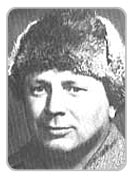Mudhole Smith
 When you hear a nickname like "Mudhole," you just know the person behind it must be something special, and so it was with Merle Smith.
When you hear a nickname like "Mudhole," you just know the person behind it must be something special, and so it was with Merle Smith.
He was a bush pilot supreme, one of that special breed of hearty individuals who overcame all the obstacles to make air transportation a reality in the remote reaches of Alaska.
Born near Colony, Kansas, Smith began his flying career as a barnstormer in the Midwest. At one time, he had his own flying circus. His first job flying in Alaska was with Cordova Air Service and he continued to serve the town and its people throughout his 43-year aviation career.
After being offered the job by Cordova's president M. D. "Kirk" Kirkpatrick in 1937, Mudhole hitchhiked to Seattle and boarded an Alaska Steamship vessel bound for Cordova. His first assignment was to fly to McCarthy, about 150 miles northeast of Cordova.
"You can't miss McCarthy," Kirkpatrick assured him. "Just follow the railroad tracks."
Mudhole did just that, until the fog closed in. Then he went on instinct.
Bob Reeve, another legendary bush pilot, has been credited with tagging Smith with the nickname of "Mudhole." Smith was flying to the Bremner Mine, south of McCarthy. It was a run that Reeve usually made during the winter months when the frozen ground provided a solid place to land. Smith made the trip during the summer. The field was just a short stretch of rocks on soggy tundra. When the old Stearman bi-plane touched down, its tailskid knocked aside one of the rocks, leaving a large hole in the field.
Later, when Smith attempted a takeoff after a rain that made the field soggier than ever, a wheel dropped into the hole. The plane nosed into the mud, with the propeller turning at about 1,800 RPM.
Mudhole spent the night scraping the mud out of the engine, part by part. His tools consisted of a putty knife, a screwdriver and an old rag. The next day he lifted off from the mine and returned to Cordova.
Reeve, who was in Valdez at the time, overheard Smith reporting the incident to his boss over the radio. From the beginning, he had not been particularly pleased that Smith had taken a run that he considered his own, so as soon as he heard of Smith's misfortune, Reeve christened him "Mudhole." It stuck. Right to the end—which came on June 16, 1981, at age 72—everyone just called him Mudhole.
In 1939, Kirkpatrick was killed when attempting to land in a snowstorm in Orca Inlet. Smith was asked to assume the presidency of Cordova Air Service. He accepted and eventually bought out the other directors and continued to run the company until its 1968 merger with Alaska Airlines.
During those years, he flew his share of rescues, mercy missions, and adventuresome trips upon which the legends of the bush pilots were built in those early days.
When the merger between Alaska and Cordova took place, Smith became a director of Alaska Airlines, a post that he held until mid-1973. He also served as a vice president of Alaska Airlines during those years.
The merger agreement allowed Smith to retain a charter service, Chitina Air Service, which he and his son, Wayne, operated for several years.
When he retired in 1979, Smith made a statement in an address to the Cordova Chamber of Commerce that perhaps best sums up his career. He said, "These 43 years have been what I wanted to do." One has difficulty imagining the feisty Smith doing anything that he really didn't want to do.